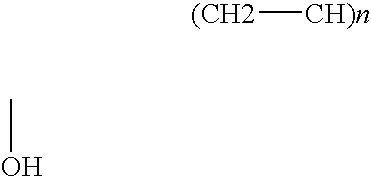Detergent particle
a technology of detergent particles and detergent powders, which is applied in the direction of detergent powders/flakes/sheets, detergent compositions, soap detergent compositions, etc., can solve the problems of reducing the usefulness of such a process for preparing enzyme particles and particles comprising other active ingredients, and the freeze drying step is not always compatible with all enzymes, so as to improve the effect of thermostability, and reduce the generation of dus
- Summary
- Abstract
- Description
- Claims
- Application Information
AI Technical Summary
Benefits of technology
Problems solved by technology
Method used
Image
Examples
example 1
A viscous mixture is prepared by dispersing 237 grams of Polyvinyl alcohol powder (Trade Name: Mowiol 3-83) into 228 grams of water and 35 grams glycerol (Sigma / Aldrich 13487-2). The solution is agitated and heated to 90° C. for one hour to ensure complete dissolution. The resultant mixer is allowed to cool to 25° C. 314 grams of high alkaline protease concentrate (enzyme concentrate 100 mg / g; Aqueous Slurry contains 20% total solids) is added to a cool (25° C.) polymeric viscous solution into a Kenwood-type food mixer. The mixer is operated at maximum speed to foam up the viscous mixture. Air is added within the mixture at a volume ratio of 3 parts air to 1 part viscous mixture as a result of this physical mixing. The said foamed mixture is extruded through a 700 micron diameter aperture using a standard ram extruder (Equipment supplier: Instrom) to form foamed noodles. The noodles are dusted with anhydrous calcium chloride and air dried until the resulting moisture content of the...
example 2
A viscous mixture is prepared by dispersing 237 grams of Polyvinyl alcohol powder (Trade Name: Mowiol 3-83) into 228 grams of water and 35 grams glycerol (Sigma / Aldrich 13487-2). The solution is agitated and heated to 90° C. for one hour to ensure complete dissolution. The resultant mixer is allowed to cool to 25° C. 314 grams of high alkaline protease concentrate (enzyme concentrate 100 mg / g; Aqueous Slurry contains 20% total solids) is added to a cool (25° C.) polymeric viscous solution into low agitation batch mixer. The mixture is slowly agitated for 15 minutes to being careful not to incorporate air into the mixture. The mixture is left to stand for a further 30 minutes to allow for degassing. Said mixture is extruded through a 700 micron diameter aperture using a standard ram extruder (Equipment supplier: Instrom) to form noodles. The noodles are dusted with anhydrous magnesium chloride and air dried until the resulting moisture content of the noodles were 5% by weight of noo...
example 3
A viscous mixture is prepared by dispersing 237 grams of Polyvinyl alcohol powder (Trade Name: Mowiol 3-83) into 228 grams of water and 35 grams glycerol (Sigma / Aldrich 13487-2). The solution is agitated and heated to 90° C. for one hour to ensure complete dissolution. The resultant mixer is allowed to cool to 25° C. 314 grams of a concentrate of Bacillus licheniformis amylase (enzyme concentrate 150 mg / g; Aqueous Slurry contains 20% total solids) is added to a cool (25° C.) polymeric viscous solution into a Kenwood-type food mixer. The mixer is operated at maximum speed to foam up the viscous mixture. Air is added within the mixture at a volume ratio of 3 parts air to 1 part viscous mixture as a result of this physical mixing. The said foamed mixture is extruded through a 400 micron diameter aperture using a standard ram extruder (Equipment supplier: Instrom) to form foamed noodles. The noodles are dusted with anhydrous calcium chloride and air dried until the resulting moisture c...
PUM
| Property | Measurement | Unit |
|---|---|---|
| particle size | aaaaa | aaaaa |
| molecular weight | aaaaa | aaaaa |
| particle size | aaaaa | aaaaa |
Abstract
Description
Claims
Application Information
 Login to View More
Login to View More - R&D
- Intellectual Property
- Life Sciences
- Materials
- Tech Scout
- Unparalleled Data Quality
- Higher Quality Content
- 60% Fewer Hallucinations
Browse by: Latest US Patents, China's latest patents, Technical Efficacy Thesaurus, Application Domain, Technology Topic, Popular Technical Reports.
© 2025 PatSnap. All rights reserved.Legal|Privacy policy|Modern Slavery Act Transparency Statement|Sitemap|About US| Contact US: help@patsnap.com


